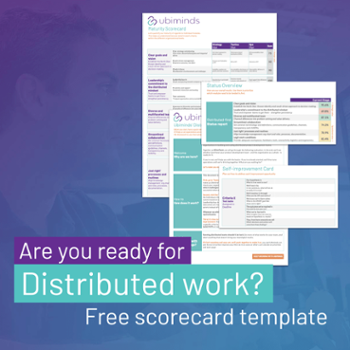Performance Management for the remote employees that make up digital product teams isn’t much different than that of on-site team members. However, the way in which we carry out interactions and apply emotional intelligence to deal with every day in currencies deserves extra attention.
The first thing CTOs like myself must learn when setting up digital product teams for distributed work is that change begins with us. There is no room for micromanagement in distributed teams, and leaders have to learn to trust their subordinates.
There are two aspects that influence digital product team leadership we should filter our analysis by. First, how well-established the organizational chart is. Do people have too much on their plate? Second, if performance management is focused on value delivery instead of pointing fingers.
Have a look at the table below: the closer you are to the right, the more mature your digital product is in regards to remote work:
| Organizational chart | Limited knowledge on how to conciliate skillsets Too many hats | Kickoff continuous improvement through self-learning | Departmentalization Benchmarking and upskilling begin | High-functioning, multidisciplinary teams come together | Temp squads set up according to needs x specialization |
| Performance management | Undefined improvement processes | Reactive improvement | Proactive improvement loops (PDCA) | Data-driven improvement | Predictive intelligence |
As you can imagine, this is both a cultural and procedural matter – and leaders more than anyone should be well aware of it.
How to manage the performance of distributed teams
So how can you carry out Performance Management for remote employees and get the best outcomes from your digital product team? I suggest looking at three factors:
- Strong communication for better autonomy
- Result-driven management and integrated SDLC
- Clear KPIs and proactive improvement loops
#1 Strong communication for better autonomy
If anything, distributed teams need to over-communicate to make sure everyone remains on the same page. Performance Management for remote employees depends on constant and frequent feedback and feedforward. Albeit one-on-one time is important, omnichannel and async positive reinforcement is a necessary plus.
There is more to it, though. It’s about when, how, and why you share information, and of what kind. The US Office of Personnel Management has excellent tips I will borrow from:
- establish strong working relationships with employees,
- promote easy access to information and feedback,
- promote employee involvement in planning and development activities, and
- recognize and praise the top performers.
By doing so, you will be able to (a) plan and communicate work expectations, (b) carry out necessary alignments along the way, and (c) recognize team members for their achievements.
With a clear understanding of the road ahead and what each team member is meant to deliver, there is room for self-accountability and proactivity. And you, as a leader, can leave micromanagement days behind. In fully-functioning distributed teams, people are empowered and ownership is the norm.
#2 Result-driven management and integrated SDLC
Building on the last topic, it’s important for leadership to understand exactly where those expectations should lie. Unfortunately, it is still common to find businesses that focus on effort (number of hours, etc.), instead of value delivered.
The team should be praised and rewarded on outcomes – and deadlines -, and it is quite important to escape from the feature roadmap to outcome-driven development. Or, as put by Alice Rex in Mind the product:
“You need to say no to features and start talking about problems. You need to start talking about outcomes. What will the world look like if your team succeeds in the next year? How will your customers feel, and what will they now be able to do?”
For the desired outcomes to be met, there needs to be space for everyone within the team – and outside it – to provide input. That is why integrated Software Development Lifecycles (SDLC) are so important. Full-on collaboration between Management, Product Design, and Engineering should include peer assessment.
In fact, digital product teams that are already mature in their remote collaboration frameworks are able to set up temporary teams focused on context-based challenges. When your goal is result-driven, you are able to set up high-functioning, multidisciplinary squads according to needs and specializations.
#3 Clear KPIs and proactive improvement loops
It seems old, but SMART performance metrics – Specific, Measurable, Achievable, Relevant, and Timely goals – are crucial to business decisions. Be sure to look at indicators that measure product, processes, and people… then use this data to execute data-driven continuous improvement.
Proactive improvement loops, such as business management’s Plan/Do/Check/Act (PDCA) cycle gain effectiveness when number-based objectivity is added. Performance Management for remote employees has to be recurrent, but also systematic so that you can quantify and qualify improvement.
If you are looking to improve the outcomes of your distributed digital product team, take a look at Ubiminds’ Distributed Culture Maturity Assessment by clicking the link below. In under 10 minutes, you can find out whether your product team is ready to thrive through distributed work.
Would you rather chat with us directly? Fill out the form below and book a quick chat!

Paulo Ross, CEO at Ubiminds. Forever a software developer, entrepreneur, people-person, and devoted dad. Empowering teams to grow and deliver value.







